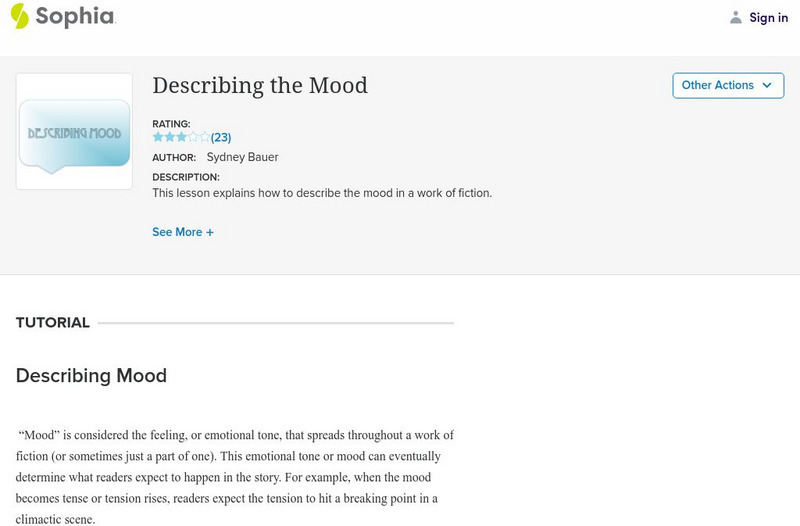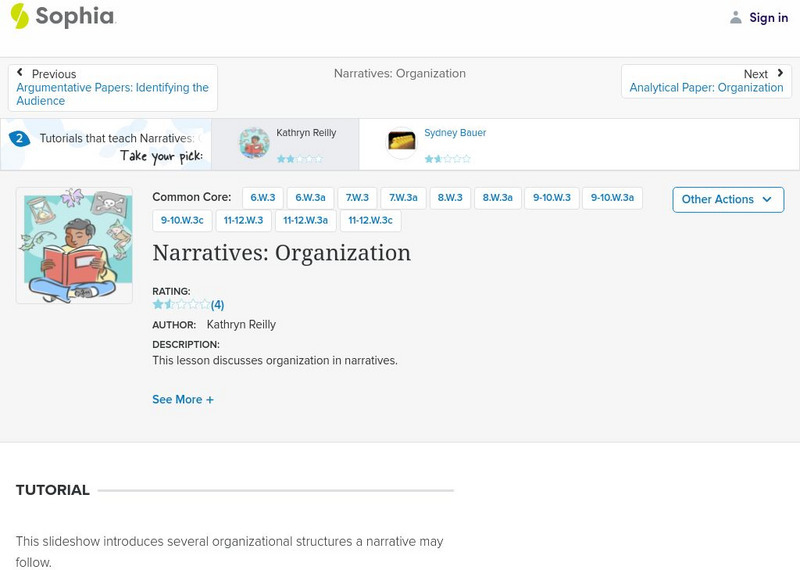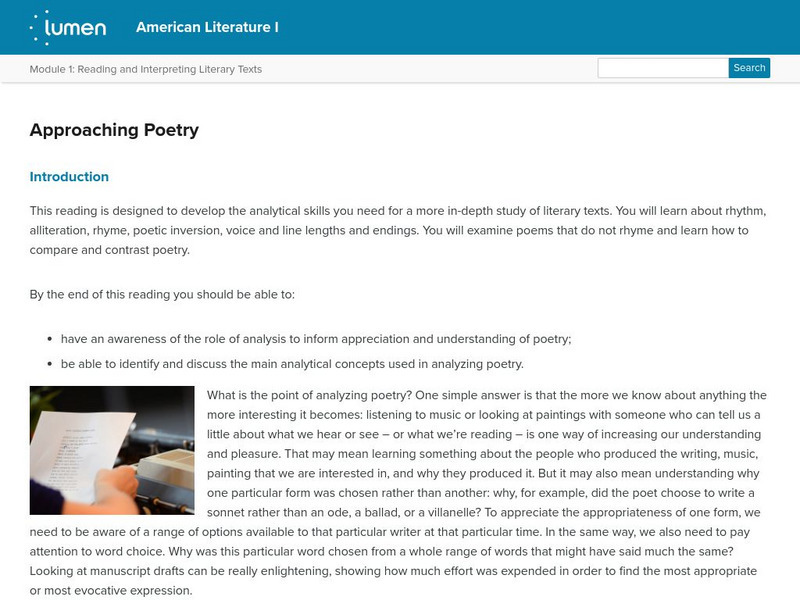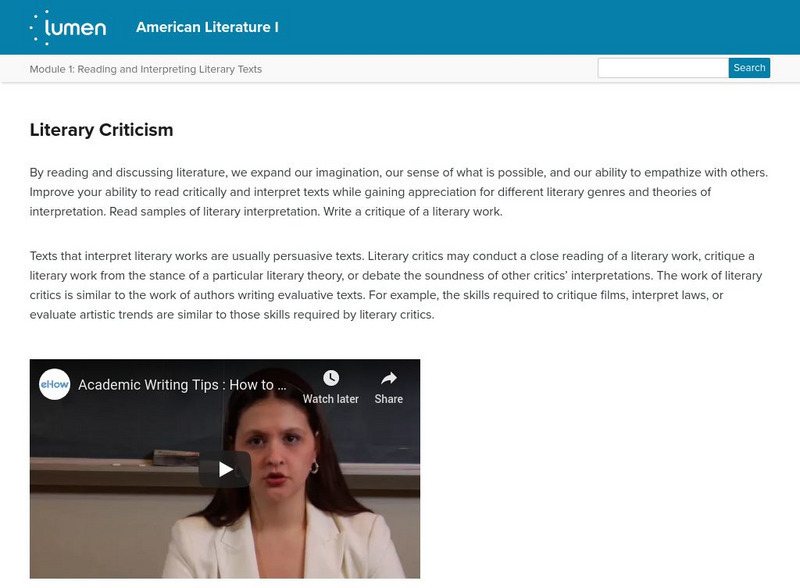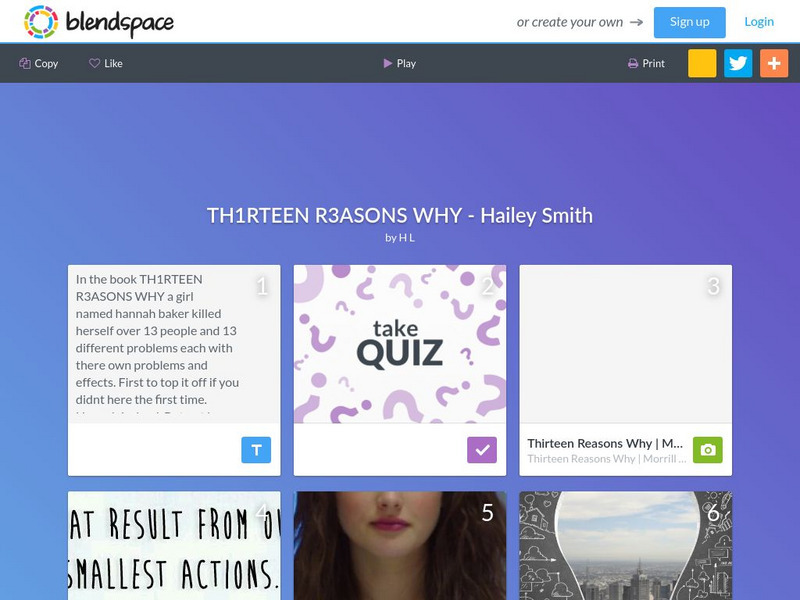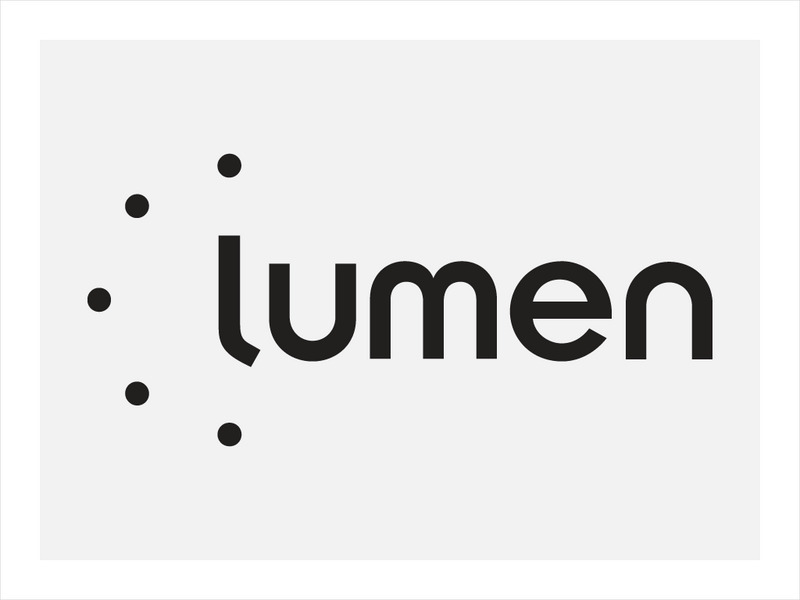Other
Georgia Perimeter: Choosing and Writing for an Audience
This resource goes extensively into the importance of establishing an audience when writing. It also defines types, how to choose, and how to write for an audience.
University of Victoria (Canada)
The U Vic Writer's Guide: Literary Term: Plot
This page offers a detailed overview of plot, including its various aspects and use in various types of literary works.
University of Victoria (Canada)
The U Vic Writer's Guide: Literary Term: Novel
This site provides a general overview of the novel, including its history and generic forms. Includes a few examples and related links.
University of Victoria (Canada)
The U Vic Writer's Guide: General Literary Terms
The University of Victoria's Writer's Guide includes an extensive list of literary and rhetorical terms. List can be displayed alphabetically.
Houghton Mifflin Harcourt
Holt, Rinehart and Winston: Elements of Literature: Narrator Chart [Pdf]
Provides an overview of the importance of a narrator in a text and some brief exercises for analysis. Helps students learn more about the role of the narrator in literature, his/her voice, and influence on other characters and events.
Sophia Learning
Sophia: Hey, I Known That Song: Literary Analysis of Popular Music
This PDF lesson plan uses the Lyrics to "I Was a Kaleidoscope" by Ben Gibbard and the song "I Was a Kaleidoscope" by Death Cab for Cutie to analyze the poem and determine its meaning.
Sophia Learning
Sophia: Characterization
This slideshow focuses on characterization including defining and discussing the 5 methods of characterizations: speech, action, description, interaction, and thoughts with examples of each. It also covers the importance of...
Sophia Learning
Sophia: Describing the Mood
Information that can be read or listened to that describes how to identify and write about the mood of a piece. Examples are provided using the story of "Tell Tale Heart" by Edgar Allen Poe.
Sophia Learning
Sophia: Selecting Topics for Literary Analysis
A series of three PDF documents providing definitions of commonly used terms when preparing to write a literary analysis, explaining how to comment on a literary text, and demonstrating the process of analyzing the literary text "Hills...
Sophia Learning
Sophia: Suspense
This slideshow focuses on the use of suspense in fiction by stating the purpose of suspense, discussing four ways authors create suspense, showing that all forms of literature contain suspense, and presenting an example with John...
Sophia Learning
Sophia: Analyzing the Author
A slideshow with ten slides that discusses the difference between a subject and a theme and gives several examples of each found within a variety of popular classical and modern texts.
Colorado State University
Writing@csu Guide: Understanding Writing Situations
In this guide, you can learn more about the situations in which writers and readers find themselves and the physical, social, cultural, and historical contexts that shape them. Click on each of the links on the right to learn about the...
ReadWriteThink
Read Write Think: Defining and Exploring an Author's Stylistic Choices
Contains plans for two lessons that teach students how to recognize an author's use of style in literature. These plans use "Their Eyes Were Watching God" by Zora Neale Hurston as an example, but the basic ideas can be adapted to other...
Sophia Learning
Sophia: Narratives: Organization
This slideshow lesson focuses on organizational structures for narratives including a review of narratives and a list of possible organizational structure types: chronological or sequential order, climactic order, in media, and...
Other
Teengagement: Targeted Intervention: Word Choice Shapes Meaning and Tone
In this instructional activity, students interpret how words are used in a literary text and examine how word choice affects meaning and tone. A sample analysis of a poem is presented, terms are defined, and question stems for assessment...
Texas Education Agency
Texas Gateway: Evaluate Tone in Various Media for Different Audiences/purposes
Explain how the tone of a message varies according to audience and purpose.
Lumen Learning
Lumen: Reading and Interpreting Literary Texts: Approaching Poetry
This instructional activity focuses on the how to approach the analysis of poetry. It provides a series of student activities such as having students read and compare a draft and the final version of William Blake's "Tyger" which is...
Lumen Learning
Lumen: Reading and Interpreting Literary Texts: Literary Criticism
This lesson focuses on how to write a literary criticism, the different theories and approaches to literary criticism, and their standard format.
TES Global
Blendspace: Th1rteen R3asons Why
A set of resources to support a unit on Jay Asher's 13 Reasons Why. Includes quiz and images showing sadness, settings, etc.
Lumen Learning
Lumen: Introduction to Writing About Literature
This is an introduction to writing about literature; it includes a list of learning objectives for writing about literature including finding and using historical sources to discuss the historical context, finding and using literary...
Lumen Learning
Lumen: Writing About Literature: Additional Resources
This is "'The Legend of Sleepy Hollow': An Allegory for a Young America," an exceptional student example of literary analysis as well as an explanation to the main body of her paper. A link to the MLA website is also provided.
Lumen Learning
Lumen: Reading and Interpreting Literary Texts: How to Analyze a Short Story
This lesson focuses on analyzing a short story including all of the elements of a short story such as setting, plot and structure, and characterization.
Lumen Learning
Lumen: American Literature: Reader Response Criticism
This lesson focuses on reader-response literary criticism including the purpose of reader response, the structure of a reader-response essay, how to criticize with examples, and an example of a reader-response essay using "The Secret...
Victorian Web
The Victorian Web: The Wildean Dandy, and Comedy, and the Picture of Dorian Gray
This Victorian Web essay provides insight on writer Oscar Wilde's personality and how it relates to his comedy. The article is entitled, "The Wildean Dandy, Comedy, and the Picture of Dorian Gray." This site also gives excerpts from some...





![Holt, Rinehart and Winston: Elements of Literature: Narrator Chart [Pdf] Graphic Holt, Rinehart and Winston: Elements of Literature: Narrator Chart [Pdf] Graphic](http://content.lessonplanet.com/resources/thumbnails/410058/large/bwluav9tywdpy2symdiwmduymc03nzcylxblamtwbi5qcgc.jpg?1589985144)


